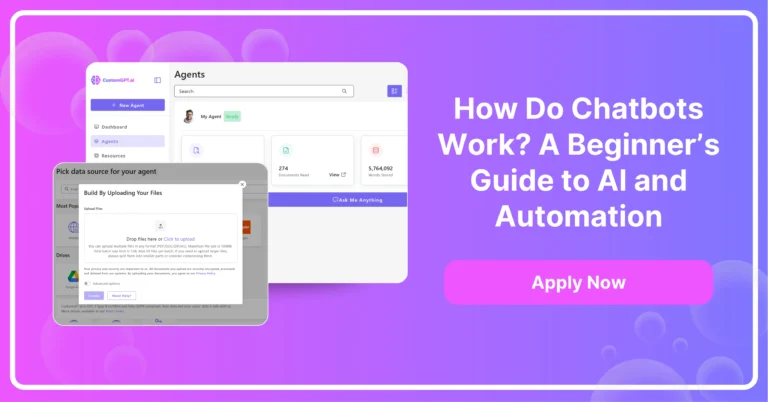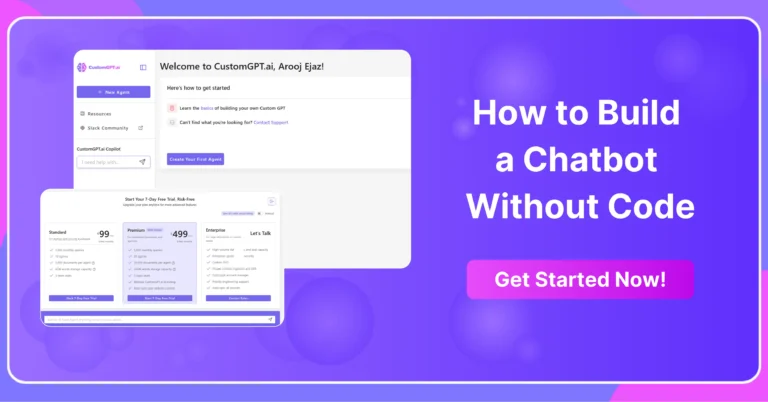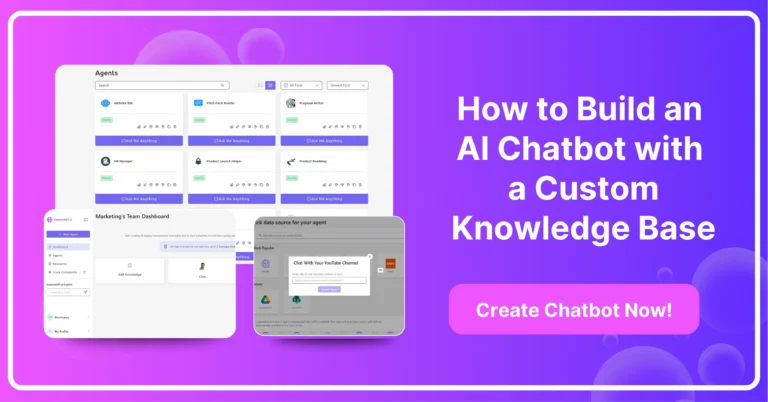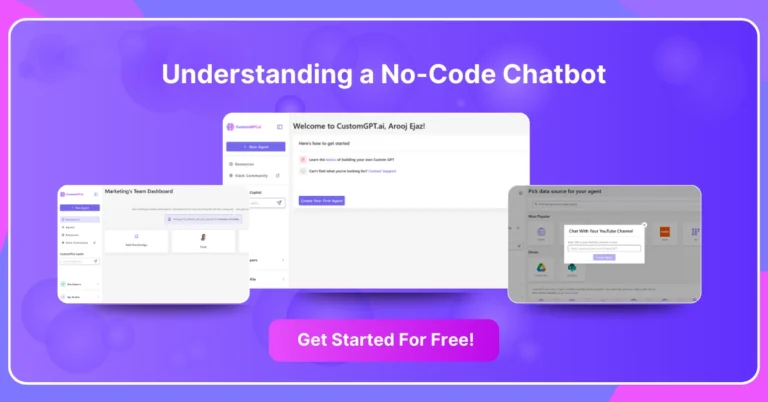A custom AI agent changes how organizations access data and automate tasks by providing domain-specific responses and actions, making interactions more intuitive and effective.
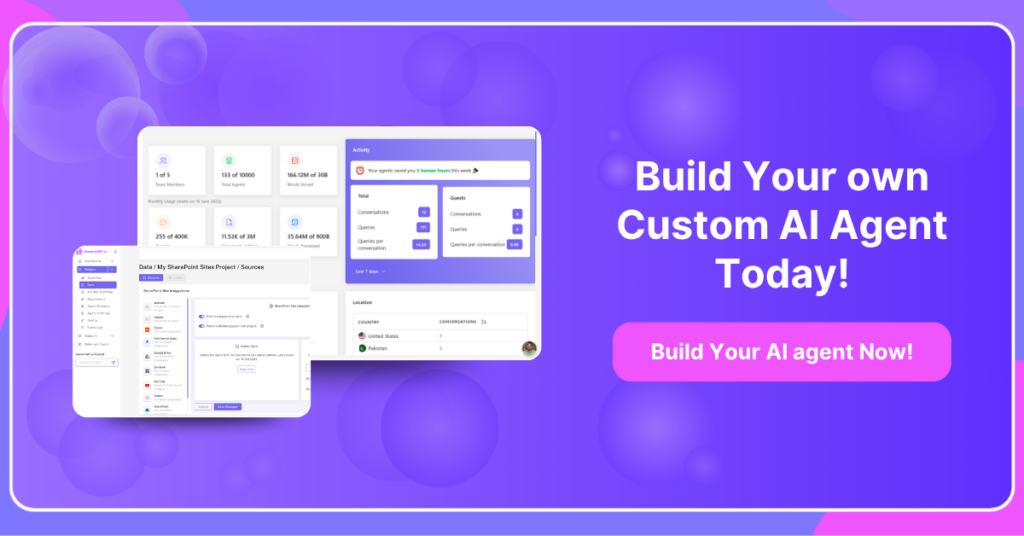
A custom AI agent enables organizations to access data and automate tasks with tailored responses, making interactions intuitive and effective.
Unlike general AI models that serve broad purposes, custom agents are fine-tuned to a specific context and audience. This specialization allows them to handle niche queries and complex workflows with greater precision.
Building a custom AI agent involves a series of clear steps, starting with gathering relevant domain data and defining precise objectives.
Next comes selecting or fine-tuning a foundation model, designing conversational flows, and setting up the infrastructure for deployment.
As you build your agent, you’ll iterate on design, test performance, and refine responses so it meets requirements and adapts to evolving needs.

Defining Custom AI Agent
Custom AI agents excel because they are purpose-built, leveraging domain-specific fine-tuning to align with unique operational needs. Unlike generalized models, these agents are trained on proprietary datasets, enabling them to interpret nuanced contexts and deliver highly relevant outputs.
This specificity is critical in industries like healthcare, where compliance and precision are non-negotiable.
The process begins with curating high-quality, structured data. Techniques like semantic indexing and entity recognition ensure the agent understands relationships between concepts, improving its ability to retrieve and process information.
For instance, a financial services firm might train its agent on regulatory documents and transaction patterns, enabling it to flag anomalies with unparalleled accuracy.
However, challenges arise when datasets are incomplete or biased. Addressing these requires iterative refinement and human-in-the-loop (HITL) strategies, which allow real-time adjustments to outputs. This ensures the agent remains adaptable and reliable, even in edge cases.
By centralizing diverse knowledge sources on platforms like CustomGPT.ai, businesses can deploy agents that not only answer questions but also drive measurable outcomes, such as reducing helpdesk response times or enhancing employee training efficiency.
The Growing Importance of Custom AI
Custom AI’s transformative power lies in its ability to align with the intricate demands of specific industries. One often-overlooked aspect is the role of semantic AI in enabling these agents to interpret and respond to nuanced queries.
Unlike traditional keyword-based systems, semantic AI maps user input to deeper meanings, ensuring that responses are contextually accurate and relevant.
In multi-turn conversations, maintaining context is essential. For example, a healthcare AI agent using semantic indexing can track patient history to offer tailored advice without repeated input, enhancing experience and reducing cognitive load.
However, achieving this level of precision requires meticulous data preprocessing. Techniques like co-occurrence analysis and salience detection ensure that the AI understands relationships between terms, improving its ability to handle complex, domain-specific queries.
By integrating these advanced techniques into platforms like CustomGPT.ai, businesses can deploy agents that not only answer questions but also anticipate needs, driving operational efficiency and trust.
Benefits of Custom AI Agents
Custom AI agents unlock tailored solutions by leveraging domain-specific data and fine-tuning models to align precisely with unique business needs, resulting in more accurate, efficient, and context-aware interactions.
- Increased accuracy and relevance through training on proprietary or specialized datasets
- Enhanced efficiency by automating repetitive or complex workflows
- Better user experience due to context-sensitive responses and personalized interactions
- Improved decision-making with insights drawn from internal data sources
- Stronger data security and privacy, as sensitive information stays within controlled environments
- Cost savings over time by reducing manual efforts and streamlining processes
- Competitive advantage through unique capabilities that generic models cannot replicate
- Scalability and adaptability, allowing the agent to evolve as requirements change.
Custom AI Agents vs. General AI Models
Custom AI agents are specifically tailored to address unique business requirements and leverage proprietary data for precise, context-aware interactions, whereas general AI models are designed for broad applicability across various domains without specialized customization.
| Feature | Custom AI Agents | General AI Models |
| Data Training | Fine-tuned on proprietary or domain-specific datasets | Trained on large, generic public datasets |
| Accuracy & Relevance | High, optimized for niche tasks and specialized queries | Moderate, broad understanding but may lack depth in specific areas |
| Deployment Complexity | Higher, requires infrastructure setup, API integration, and ongoing tuning | Lower, often available through turnkey APIs with minimal setup |
| Flexibility | Highly customizable workflows, responses, and decision logic | Limited customization, designed to handle a wide range of inputs |
| Security & Privacy | Enhanced, data remains within controlled environments | Standard, data may pass through third-party servers |
| Maintenance & Updates | Requires continuous retraining and refinement | Periodic model updates by the provider |
| Cost Considerations | Higher initial investment, but cost-effective for long-term specialized use | Lower upfront costs, but potential inefficiencies for specific tasks |
| Use Cases | Customer support bots trained on internal documentation, industry-specific assistants | Chatbots for general queries, broad-language tasks, content generation |
Traditional Method for Building a Custom AI Agent
Creating a custom AI agent involves more than picking a model, it’s about tailoring the entire system to your unique requirements, data, and workflow.
By following a clear sequence of steps, from defining goals to deploying and monitoring, you can ensure that your agent delivers accurate, context-aware responses that drive real value.
Step 1: Define Objectives and Use Case
Begin by outlining what you want your AI agent to achieve. Specify the domain (e.g., customer support, internal knowledge base, industry-specific advisor), target users, and the key tasks it should handle. Clearly defined goals will guide data collection and architectural decisions.
Step 2: Gather and Preprocess Domain Data
Collect relevant data that reflects your specific context—this might include company documents, user logs, support tickets, or specialized corpora. Clean and annotate this data (remove duplicates, correct formatting, label intents) so it’s ready for model training and evaluation.
Step 3: Select and Fine-Tune a Foundation Model
Choose a base model (such as a pretrained language model) that aligns with your requirements (size, performance, latency). Fine-tune this model on your domain dataset, adjusting hyperparameters and training epochs until it reliably produces accurate, contextually relevant outputs.
Step 4: Design Conversational and Decision Logic
Craft the rules or flowcharts that dictate your agent’s behavior: how it interprets user inputs, decides which actions to take, and formulates responses. This may involve slot-filling for forms, fallback strategies for unknown queries, and branching logic to route conversations appropriately.
Step 5: Build API Endpoints and Infrastructure
Set up the backend infrastructure to host your fine-tuned model, this includes servers (cloud or on-premises), containerization or virtualization, and RESTful or graph-based API endpoints. Ensure scalability, security, and ease of integration with front-end interfaces or existing systems.
Step 6: Test, Validate, and Refine
Test with hold-out queries and real scenarios, measure accuracy, latency, and satisfaction, gather beta feedback to spot failures, then retrain or adjust and repeat until performance is satisfactory.
Step 7: Deploy, Monitor, and Maintain
Deploy your AI agent to production and use monitoring tools to track usage patterns, error rates, and performance drift. Schedule regular retraining with new data and user feedback to keep the agent aligned with evolving requirements.

Limitations and Complications of Traditional Methods
Traditional approaches to building a custom AI agent often involve extensive manual effort, complex workflows, and significant resource investments, which can delay deployment and reduce flexibility.
- Data Collection and Annotation Overhead: Gathering domain-specific data and accurately labeling it is time-consuming and costly, often requiring subject-matter experts.
- Lengthy Development Cycles: Training models from scratch or heavily fine-tuning large pretrained models can take weeks, sometimes months, of experimentation and tuning.
- Infrastructure Complexity: Setting up secure, scalable servers, APIs, and monitoring systems demands specialized engineering skills and ongoing maintenance.
- Difficulty Capturing Domain Nuances: Translating expert knowledge and business logic into training data and rules often leads to gaps in understanding or inconsistent performance.
- Rigidity and Maintenance Burden: Once deployed, traditional agents can be hard to update, adding new data sources or adapting to changing requirements often requires retraining and redeploying the entire system.
- High Costs: Licensing pretrained models, procuring cloud compute for training, and hiring skilled engineers can add up, making traditional method prohibitively expensive for many organizations.
CustomGPT.ai to Launch Your Custom AI Agent
CustomGPT.ai simplifies building tailored AI agents by managing infrastructure, fine-tuning, and deployment in one platform. Simply upload domain data and set high-level options without handling servers or integrations.
With built-in templates and guided workflows, CustomGPT.ai accelerates model training and iteration, allowing you to see results within hours instead of weeks. Automated evaluation metrics and feedback loops ensure that your agent’s performance continually improves as you refine your training data.
Seamless API integration means your custom AI agent can be embedded into websites, chat interfaces, or internal tools with minimal code, eliminating the need for separate API development.
CustomGPT.ai also offers scalable hosting, so your agent adapts effortlessly to fluctuating user demand without manual intervention.

Building an AI Agent with CustomGPT.ai
CustomGPT.ai simplifies the process of creating a tailored AI agent by providing an all-in-one platform for data ingestion, model fine-tuning, and deployment.
With minimal setup and automated workflows, you can focus on defining your agent’s behavior and training it on your own data rather than managing infrastructure.
Step 1: Set Up Your Workspace
Sign up on CustomGPT.ai and create a new project workspace to centralize datasets, training runs, and deployment settings. This unified dashboard simplifies managing all aspects of your agent.
Step 2: Prepare Your Domain Data
Gather relevant documents, FAQs, or support logs that represent your use case and clean them by removing duplicates and fixing formatting. Properly labeled, high-quality inputs will ensure your model learns from accurate and structured data.
Step 3: Fine-Tune Your Model
Select a base model and configure essential hyperparameters like learning rate and batch size. Click “Start Training” to let CustomGPT.ai handle compute resources and logging, while you monitor loss curves and accuracy in real time.
Step 4: Test and Validate in the Sandbox
Use the built-in sandbox to simulate user interactions and evaluate responses against your test cases. Refine prompts or fallback strategies until your agent consistently delivers accurate, context-aware outputs.
Step 5: Deploy and Monitor Performance
Generate API keys and embed the provided endpoint into your application, ensuring proper authentication and rate limits. Leverage CustomGPT.ai’s monitoring tools to track usage, response times, and user feedback, then iterate on your data or model as needed.

Build custom AI agent that transform your business operations!
Boost efficiency with innovative, personalized, and reliable custom AI agent.
Get started for freeFAQ
What is a custom AI agent?
A custom AI agent is a purpose-built system fine-tuned on proprietary data to perform domain-specific tasks. It delivers context-aware responses by understanding unique workflows and business requirements.
What are the benefits of a custom AI agent?
Custom AI agents offer improved accuracy and relevance by leveraging specialized datasets. They enhance efficiency and user experience through personalized, context-sensitive interactions.
How does a custom AI agent differ from a general AI model?
Custom agents are trained on niche, proprietary datasets to handle specialized queries, whereas general models use broad public data for wide applicability. This specialization enables custom agents to outperform generic models on specific tasks.
What are the traditional method to build a custom AI agent?
Traditional methods start with defining objectives and gathering domain data, followed by model selection and fine-tuning on that data. Subsequent steps include designing conversational logic, setting up infrastructure, testing rigorously, and deploying with ongoing monitoring.
How does CustomGPT.ai simplify building a custom AI agent?
CustomGPT.ai provides an end-to-end platform that handles data ingestion, model fine-tuning, and deployment workflows automatically. Users upload domain data, configure high-level settings, and leverage built-in tools for testing, API integration, and performance monitoring.
Conclusion
Custom AI agents transform how businesses leverage AI by providing tailored, context-aware solutions that outperform generic models in niche tasks. They deliver precise, relevant results that adapt to specific industry needs and user scenarios.
Platforms like CustomGPT.ai streamline this entire process, enabling rapid development and deployment with minimal technical overhead. Continuous improvement is built in, allowing your chatbot to evolve as your data and requirements change.
Build your own personalized AI chatbot using CustomGPT.ai’s personalized AI chatbot solution. Empower your business with a custom agent that scales and adapts to your unique needs.
Build custom AI agent that transform your business operations!
Enhance customer experience with smart, accurate and custom AI agent.
Trusted by thousands of organizations worldwide





